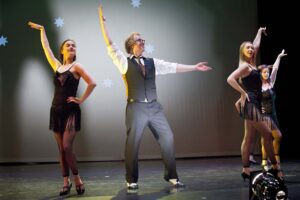Dr Dance Peter Lovatt decodes why some booty shaking is hot and some not

Why do some clubbers shake it like a Polaroid picture while others prefer to perch on a bar stool? British psychologist Peter Lovatt, who has conducted rigorous field work in nightclubs, believes he can explain why some booty shaking is hot — and some is not. It’s all about your hormones. For reasons of data protection and privacy, your IP address will only be stored if you are a registered user of Facebook and you are currently logged in to the service. For more detailed information, please click on the “I” symbol.
But what exactly happens when the beat kicks in? Why are some folks bursting with confidence and other not? What dance styles are most likely to find you a potential mate? If one is to believe psychologist Peter Lovatt, three factors influence how confidently an individual moves on the dance floor and how attractive the other gender finds the performance. Those factors are age, gender and genes.
Lovatt, a psychology professor at the University of Hertfordshire near London who is widely known as “Dr. Dance,” bases his conclusions on rigorous field work. Dr. Dance visited a nightclub at his university, his mission was to find out which style of dancing was most attractive to the opposite sex, and why.
Dr Dance Peter Lovatt
The Research
His students measured clubbers’ ring and index fingers. The relationship between the two fingers is believed to be related to how much testosterone an individual was exposed to in the womb. If the ring finger is longer than the index finger, it suggests a high level of prenatal testosterone.
Lovatt and his team observed the dance floor closely and took certain dancers aside for a solo performance. Those selected groovers were then filmed for 30 seconds on a separate dance floor which was, according to Lovatt, “just as lively and noisy as the main dance floor.” Then the team headed back to the lab with their videos. Lovatt then applied a filter to the footage so that the dancers could only be seen in silhouette, which meant that any viewer had to focus solely on their movements. He showed these films to students, who had to rate the dancers on a five-point scale from “very attractive” to “very unattractive.”
The results showed that women gave the highest attractiveness ratings to men with the highest levels of prenatal testosterone. The men with the lowest testosterone in turn got the lowest attractiveness ratings. “Men can communicate their testosterone levels through the way they dance,” Lovatt said. “And women understand it without noticing it.”
Subtle Is Better
The men who got the female students hot, danced with large movements which were “complexly coordinated.” But it’s a fine line between hot and not, however: Those men who made big moves but who were less coordinated came across as dominant alpha males and were unlikely to win women’s hearts. The researchers also found that the size and complexity of the dance moves decreased in parallel with testosterone levels.
In women, the link between dancing style and testosterone levels were similar but the reaction of men was just the opposite. Dancers with high levels of testosterone moved more parts of their body, with their movements being somewhat uncoordinated, while those with lower testosterone levels made more subtle movements, especially with their hips. The male students found the latter style most appealing.
The dance master with his students
Women Don’t Like It Small
Dr. Dance’s research is easy to grasp. Everyone can appreciate that women are not attracted to men who barely move and show little imagination when they dance. Lovatt presented a variety of dance styles on BBC. First, he simply steps from left to right, moving his arms up and down. Then his side steps get wider and he raises his arms higher. After that, he keeps the size of the movements constant but changes the style, bending his arms, snapping his fingers before making circular movements with his arms. He finishes off by making uncoordinated floundering movements with his arms.
Viewers are asked to complete a questionnaire and decide which of the demonstrated styles was closest to their own dancing technique, in terms of size and complexity. In addition, participants were asked to rate their own dancing prowess compared to people of their sex and a similar age, ranging from “terrible” to “excellent.”
The response was huge, with almost 14,000 people taking part. “Everybody thought that their dancing skills are better than average for their age,” says Lovatt. Perhaps it’s not surprising, after all, who wants to admit to being a complete loser in the dancing department? But Lovatt also unearthed a less obvious finding, namely that satisfaction with one’s own dance skills, something he terms “dance confidence” developed differently in women and men over the course of their lives.
The largest degree of satisfaction can be found in girls under the age of 16. “They see dance as something fun, not as part of mating behavior,” says Lovatt. That changes around the age of 16. “Between 16 and 20, dance confidence among girls falls markedly,” says Lovatt. “Girls begin to see dance as a social act rather than a way of expressing themselves. They begin to worry about how they look and start searching for a boyfriend.”
But once young women have come to terms with their lost dancing innocence, the satisfaction ratings start rising again. From the age of 20 onwards, their opinion of their own dance floor competence starts to improve and keeps increasing until the age of 35. After that it hits a plateau, however, as satisfaction levels stagnate. From 55 onwards, the value even drops. “That coincides with the menopause,” says Lovatt. And it doesn’t get any better: “Dance confidence remains low for the rest of a woman’s life.”
The pattern is somewhat different among men. Their dance confidence levels keep rising until the mid 30s. It then stagnates before starting to sink from the age of 55 onwards. But then, surprisingly, men get a second wind. From 65 on, they start to once again see themselves as pretty smooth operators on the dance floor.
Lovatt thinks it might have to do with the falling confidence of older women, which could have a liberating effect on men. “A lot of men have come up to me and said, ‘Oh, man, I’m a terrible dancer,'” Lovatt says. “I asked them why, and they answered: ‘My wife says so.'” But if women are dissatisfied with their own dancing skills, Lovatt reasons, then they are hardly in a position to criticize their husbands, who can then feel free to release their inner Travolta.
Dr Dance says, “Optimistic people live longer, they are less likely to develop a life-threatening illness.” Hence it could be that the relative percentage of optimists in the population starts to increase from the age of 65.
So, what does Dr. Dance prescribe for those who prefer to keep their booty firmly attached to the nearest bar stool, rather than shaking it? “I don’t think there is anybody who can’t dance, you shouldn’t be afraid of your own movements, you should relax.” At the end of the day, Dr. Dance’s message is simple: “Let go, your body should move!”




